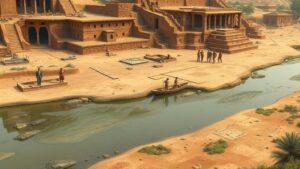The unexplored potential of underwater archeology in discovering submerged cities.
The Unexplored Potential of Underwater Archeology in Discovering Submerged Cities
Underwater archaeology is a fascinating field that has only begun to scratch the surface of its potential in uncovering the mysteries of submerged cities. As rising sea levels and natural disasters threaten coastal areas, understanding our submerged past becomes increasingly crucial. This article delves into the methodologies, challenges, and promising discoveries that highlight the unexplored potential of underwater archaeology.
The Scope of Underwater Archaeology
Underwater archaeology is defined as the study of human interaction with the sea, lakes, and rivers through the recovery of artifacts, biofacts, and other physical remains. It can include ancient shipwrecks, submerged settlements, and remnants of past civilizations. Some significant sites include:
- Antikythera Shipwreck (Greece): Discovered in 1900, this site is famous for the Antikythera mechanism, an ancient analog computer.
- Dwarka (India): Believed to be the ancient city of Lord Krishna, located off the coast of Gujarat, revealing structures that may date back thousands of years.
- Yonaguni Monument (Japan): An underwater structure that some believe to be evidence of an ancient civilization, though its origins remain debated.
These discoveries underscore the significant contributions underwater archaeology can make in rewriting history, particularly regarding urban development and societal evolution.
Research Methodologies
Underwater archaeologists employ various methodological approaches to excavate and study submerged sites effectively. Techniques include:
- Remote Sensing: Technologies such as sonar and magnetometry allow researchers to locate potential sites without physical intervention.
- Underwater Photography: High-resolution imaging helps document and analyze artifacts and structures.
- Excavation Techniques: Specialized tools, such as dredging systems and underwater tools, are employed to excavate sites safely.
These methodologies can be illustrated by the use of remote sensing in the ongoing search for the lost city of Heracleion in Egypt, where a combination of sonar mapping and underwater photography has revealed vast temple complexes beneath the surface.
The Challenges Ahead
Despite its promise, underwater archaeology faces numerous challenges that can hinder progress and discovery:
- Environmental Factors: Underwater conditions, such as currents, visibility, and water temperature, can complicate excavation efforts.
- Funding Limitations: Underwater archaeological projects often rely on grants and donations, which may limit the scope and duration of research.
- Legal and Ethical Issues: The Recovery of artifacts can lead to disputes over ownership, especially in international waters.
For example, the ongoing debate surrounding artifacts retrieved from shipwrecks in the Mediterranean highlights the need for clear international regulations governing underwater findings.
Recent Discoveries and Their Significance
Recent advancements in underwater archaeology have led to numerous groundbreaking discoveries that provide insight into past civilizations and their urban developments. e include:
- Port of Heracleion: Located near Alexandria, the discovery of this bustling ancient port town, once lost beneath the waves, has provided invaluable information about trade and culture during Pharaonic Egypt.
- Lake Titicaca in Bolivia: Archaeologists discovered ancient structures and artifacts on the seafloor, shedding light on the Aymara culture and their sophisticated farming techniques.
Such discoveries challenge preconceived notions of how ancient societies interacted with their natural environments and the technological advancements they achieved.
Real-World Applications and Future Directions
Underwater archaeology has implications beyond historical understanding; it also plays a critical role in environmental conservation and climate research. By studying submerged cities, researchers can gain insights into the impact of climate change on coastal areas today. Also, submerged cultural heritage provides opportunities for ecotourism, allowing communities to benefit economically while preserving their underwater heritage.
As technology evolves–such as the implementation of Artificial Intelligence and virtual reality in archaeological models–the capacity to explore submerged cities will only expand. This opens avenues for international collaboration among scientists, historians, and local communities, transforming submerged sites into centers for education and preservation.
Conclusion: An Ocean of Possibilities
The unexplored potential of underwater archaeology in revealing submerged cities offers an exciting frontier for understanding human history and our relationship with the environment. As technology improves and methodologies advance, the stories of our submerged past await discovery. Engaging with these histories not only enriches our understanding of civilizations long gone but also plays a crucial role in addressing contemporary concerns about climate change and cultural preservation. ocean is not merely a barrier but a treasure trove of forgotten tales waiting to be rediscovered.



